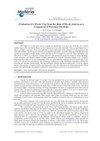Analysis of the influence of the composition and quenching parameters on the performance of some dual phase in HSLA steels
IF 1.2
4区 材料科学
Q4 MATERIALS SCIENCE, MULTIDISCIPLINARY
引用次数: 0
Abstract
Due to its combination of high mechanical properties, good formability, and low production cost, steel is a key material with potential for improvement in the metallurgical industry. Based on these conditions, this research evaluated the influence of material composition and incomplete austenitization parameters on the final metallurgical and mechanical properties of high-strength microalloyed steels after cooling in a medium with high severity. The applied cycle was based on the intercritical thermal treatment of microalloyed steels with niobium (Nb) and titanium (Ti) to increase the mechanical resistance and guarantee the tenacity of the material. An experimental study was carried out testing three intercritical temperatures, 806 °C, 775 °C, and 740 °C, with subsequent cooling in polymeric solutions in water. The studies showed that the intercritical temperature variation directly contributed to the difference in the second phase microstructure present in the samples. The heat treatment findings resulted in a microhardness of 434.2 HV0.01, characterizing the low-carbon martensite. The presence of a matrix consisting of ferrite and a second phase of low-carbon martensite promoted the typical behavior of dual phase steel. In the x ray diffraction, the presence of retained austenite was not evidenced, indicating the efficiency of the cooling rate. The experiments confirmed the influence of different engineering parameters and intercritical treatment on the mechanical properties. The study enriches the current knowledge about the development of variables for the development of dual phase steel from microalloying elements.分析了成分和淬火参数对某些HSLA钢双相性能的影响
钢具有高的力学性能、良好的成形性和较低的生产成本,是冶金工业中具有改进潜力的关键材料。基于这些条件,本研究评估了材料成分和不完全奥氏体化参数对高强度微合金钢在高强度介质中冷却后最终冶金性能和力学性能的影响。应用循环是基于铌(Nb)和钛(Ti)微合金钢的临界间热处理,以增加机械阻力和保证材料的韧性。一项实验研究测试了三个临界温度,806°C, 775°C和740°C,随后在水中的聚合物溶液中冷却。研究表明,临界温度的变化直接导致了样品中第二相组织的差异。热处理后的显微硬度为434.2 HV0.01,为低碳马氏体。由铁素体和低碳马氏体组成的基体的存在促进了双相钢的典型行为。在x射线衍射中,未发现残余奥氏体的存在,表明冷却速率的有效性。试验证实了不同工程参数和临界间处理对合金力学性能的影响。该研究丰富了目前关于微合金化元素发展双相钢的变量发展的知识。
本文章由计算机程序翻译,如有差异,请以英文原文为准。
求助全文
约1分钟内获得全文
求助全文
来源期刊

Materia-rio De Janeiro
MATERIALS SCIENCE, MULTIDISCIPLINARY-
CiteScore
1.00
自引率
25.00%
发文量
51
审稿时长
6 weeks
期刊介绍:
All the articles are submitted to a careful peer-reviewing evaluation process by the journal''s Editorial Board. The Editorial Board, reviewers and authors make use of a web based proprietary automated tool to deal with the reviewing procedures.the Revista Matéria''s article reviewing restricted access system - SEER. Authors are not informed about the identity of the reviewers.
 求助内容:
求助内容: 应助结果提醒方式:
应助结果提醒方式:


